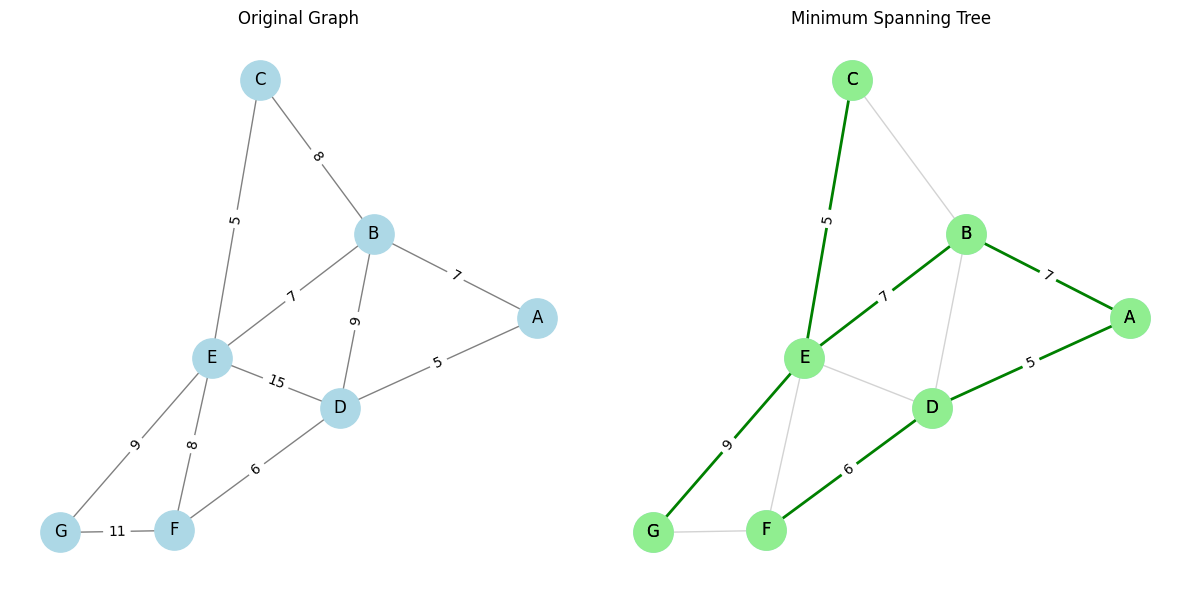🕸️ A Python Guide to Minimum Spanning Trees
When you’re designing a network — whether it’s connecting computers, cities, or pipelines — you often want to connect all nodes with the lowest possible cost.
This is the heart of the Minimum Spanning Tree (MST) problem in graph theory.
Today, we’ll solve an MST problem using Python in a Google Colab environment, leveraging Kruskal’s Algorithm and visualizing the result with networkx and matplotlib.
🌐 The Scenario: Connecting Cities
Imagine you’re tasked with connecting 7 cities with network cables.
You’re given a list of possible cable routes and the cost of each connection.
Your goal is to connect all cities using the least total cable cost, ensuring that the network remains connected (no isolated cities) and no cycles (loops) are formed.
Here’s our list of cities and connection costs:
| City A | City B | Cost |
|---|---|---|
| A | B | 7 |
| A | D | 5 |
| B | C | 8 |
| B | D | 9 |
| B | E | 7 |
| C | E | 5 |
| D | E | 15 |
| D | F | 6 |
| E | F | 8 |
| E | G | 9 |
| F | G | 11 |
🧮 Mathematical Definition
Given an undirected graph G=(V,E), where:
- V: set of vertices (cities)
- E: set of edges with weights (costs)
Find a subset T⊆E such that:
- T connects all vertices (spanning)
- T contains no cycles (tree)
- The sum of edge weights in T is minimized
Mathematically, minimize:
∑(u,v)∈Tw(u,v)
🧑💻 Python Code: Kruskal’s Algorithm
Let’s implement Kruskal’s Algorithm to solve this MST problem.
1 | import networkx as nx |
🧠 Code Explanation
networkx.Graph(): Initializes an undirected graph.add_weighted_edges_from(edges): Adds edges with costs (weights).minimum_spanning_tree(..., algorithm="kruskal"): Runs Kruskal’s algorithm.- The MST edges and their weights are printed along with the total cost.
📊 Visualizing the Network
Let’s visualize both the original graph and the resulting MST.
1 | # Position nodes using spring layout for clarity |
🔍 Visual Result Analysis
Edges in MST: A - D: 5 A - B: 7 B - E: 7 D - F: 6 C - E: 5 E - G: 9 Total Cost of MST: 39
- In the left graph, all possible connections and costs are visible.
- In the right graph, only the optimal (cheapest) connections forming the MST are shown in green.
- The MST does not contain any cycles and connects all 7 cities.
- This is the most efficient way to lay cables with a total cost of 39.
✅ Conclusion
The Minimum Spanning Tree is a powerful tool in network design, ensuring all points are connected at the lowest possible cost without redundancies.
Using networkx, we efficiently solved and visualized the MST problem in Python.
Whether you’re building data centers, road networks, or even game maps — understanding MSTs can help you make smart, cost-effective decisions.
